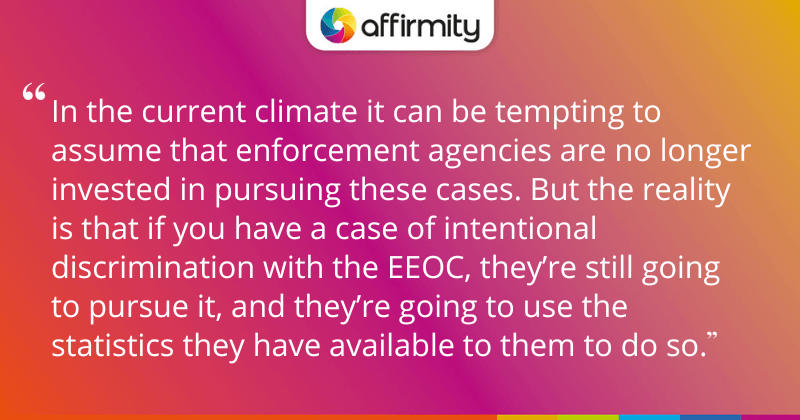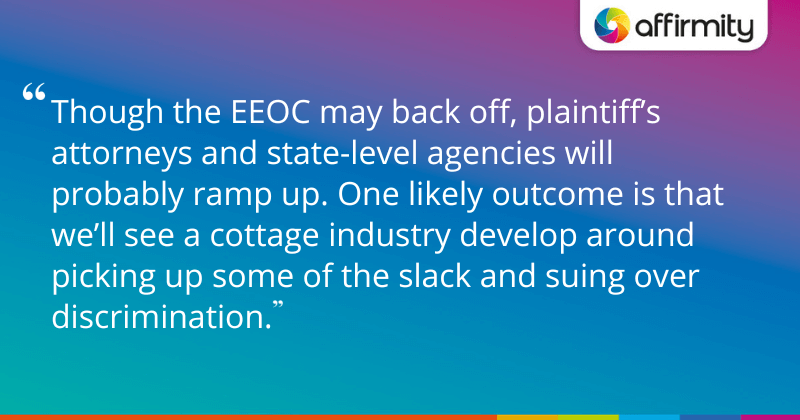Though some long-standing data collection and analysis obligations have been erased by recent executive orders, workforce demographic data collection remains a legal and practical necessity for most businesses. In this article, Affirmity Principal Business Consultant, Patrick McNiel, PhD, looks at the practical aspects of the case for continued data collection and analysis. Read on to learn about the continuing advantages of this work—and the problematic gaps that organizations risk leaving if they neglect it.
A key reason to collect workforce demographic data has always been that it protects your organization from unwarranted claims based on incomplete and/or non-objective data.
Accusations of discrimination can take a lot of different forms, and people may throw adverse impact analyses that they’ve done at you to support their claims of discrimination. Adverse impact analyses can support those accusations, but they can also refute them. If you’re on the receiving end of accusations of discrimination, especially those about a pattern of practice, you want to be able to refute them in the best way possible.
Ultimately, any data you collect internally will be a stronger source of truth than anything a plaintiff can produce—as long as you collect that data in the first place. This is because the plaintiff will typically have to rely on population statistics or other sources initially, which can be highly inaccurate proxies for the actual population proportions relevant to employment decisions. This data isn’t fitted to your processes, and cannot give an accurate representation of adverse impact at various decision points.
Nonetheless, without demographic information, an organization can’t present a true picture of populations and the effects decisions have on those populations. This will effectively cede control of the story to plaintiffs and enforcement agencies who may not be concerned with an accurate picture.

Understanding How Your Story Can Be Mistold
So, having this data is essential for accurately modeling your process, and you’ll usually uncover a far less dramatic but more accurate degree of adverse impact than another analysis would create. In short, there’s less noise in the analysis—and fewer false statistical indicators that derive from this randomness.
The OFCCP had a history of conducting large group analyses on job groups that were prone to this kind of inaccuracy. It didn’t look at requisitions and the aggregations of requisition-level results, which would have shown who is compared to whom, and would more accurately model how hiring decisions were made.
For a hypothetical example, when an organization did a recruiting push for women but made few hires as a result, an overall analysis, where everyone is thrown into a big pool, would conclude that there has been clear discrimination. After all, it looks like you’ve had 100 women and 100 men apply, and if you hired five women and 50 men. This gives an impact ratio of 10%, meaning it looks like women are hired at only 10% of the rate men are hired at.
However, if by chance (as an extreme example) all 100 women applied to one requisition and 20 men applied to that requisition, and all five women hires were made in this requisition and one male hire was made, then the female hire rate in that requisition is 5% and the male hire rate is 5%. The resulting impact ratio is one (meaning no difference in hire rates and no discrimination). The remaining requisitions only had male applicants, so men were not compared to women for decisions made about these jobs, and impact ratios can’t even be formed.
This is not a realistic example, but it does clearly show how failing to account for specific groups of people being compared to one another can lead to a false conclusion of adverse impact and discrimination rather than an understanding of the effects of efforts explicitly made to hire more women.
DISCOVER HOW OUR PRODUCTS HAVE ADJUSTED | ‘Affirmity Unveils Major Platform Update Featuring Advanced Dashboards, PayStat® Enhancements, and New UI’

Understanding What Your Story Is Telling You
Continuing to collect this data isn’t just about setting the record straight when inaccurate discrimination claims are made against you. Your demographic data has always been useful for powering statistical processes that help you pinpoint potential causes of discrimination and proactively work to address them well before a wronged party can make a legitimate claim.
For example, you may have a potential issue with discrimination that actually occurs very late in your process: the first 10,000 applicants that entered your hiring process weren’t subject to it, but the 10 who made it to the last stage were. Being able to model your process and uncover this information shrinks your liability, helps you prepare a better defense, and tells you where to take corrective action.
In the current climate it can be tempting to assume that enforcement agencies are no longer invested in pursuing these cases. But the reality is that if you have a case of intentional discrimination with the EEOC, they’re still going to pursue it, and they’re going to use the statistics they have available to them to do so.
The message for organizations is clear: be prepared.
LEARN MORE ABOUT THIS CHANGING LANDSCAPE | ‘Why Affirmative Action Should Still Be On Your Agenda: When Is an AAP Required at the Federal and State Level?’
The Long-Term Implications of Ending Workforce Analysis
Organizations that decide to discontinue data collection face a range of negative consequences in the future. These include:
i) Loss of Competitive Advantage
Adverse impact analyses allow you to determine where in your processes you might be excluding otherwise qualified people (or perhaps even the most qualified among available options). People can be removed from consideration for reasons that have nothing to do with the role at hand. You could have shift or travel requirements that disproportionately impact certain groups, and adverse impact statistics allow you to see those points and do something about them.
These analyses can ensure that you get the best people in the door: you’ll have more choice if people aren’t either self-selecting out as soon as they see those requirements, or being barred unnecessarily by your own checks. With the strongest candidates contributing to your organizational goals, you’ll have a competitive advantage over others in your industry. If you’ve made them look elsewhere, that competitive advantage will reside elsewhere.

ii) Being Unprepared for the Next Shift in the Political Winds
Further political shifts surely lie ahead, and if they follow the pattern of recent years, we can expect a continued pendulum swing from left to right and right to left, with organizations pulled back and forth between competing ideologies. Where will things stand after the midterms, or at the end of the current administration? No one can say with any real certainty, but the prospect of a flip in any and all of the branches of government could be problematic for any organization that fully abandons analysis.
When organizations fall in line with one administration, they may become a target for the next. So it’s worth considering that while you may not need demographic data right now, you may need it when the winds change—ultimately, it’s important to really pay attention to what the law actually requires and to follow it. This is the only way you can reduce your risk and protect yourself, whatever the political climate.
iii) Lacking a Defence Against Counteractive Forces
As federal-level bodies cool off on compliance and measurement practices, other entities are likely to fill the vacuum. So, though the EEOC may back off, plaintiff’s attorneys and state-level agencies will probably ramp up. One likely outcome is that we’ll see a cottage industry develop around picking up some of the slack and suing over discrimination.
Another outcome we’re already seeing is states making laws that reinforce EEO-related analysis requirements. For example, California’s ‘Proposed Modifications to Employment Regulations Regarding Automated-Decision Systems’ maintains references to adverse impact, with the implication that organizations doing business there will have to collect demographic data in order to perform an analysis.
In this respect, things are going to become more fragmented and probably more complicated. You’ll want to have that data so that you can deal with those issues as they arise.
MORE ON THE CONTINUED CASE FOR ANALYSIS | ‘5 Reasons Organizations Must Continue Performing Adverse Impact Analyses’
Conclusion: Best Practices Moving Forward
To strategically use the demographic data you collect going forward, we recommend that you:
- Consult with your legal team, outside legal counsel, and/or experienced external consultants for proper guidance on collecting and analyzing workforce demographic data
- Reach a consensus on what data you’re going to continue collecting, how you’re going to collect it, and how you’re going to use the data going forward. Consider:
- Data collection methodology
- Sources
- Processes for verifying data integrity
- Thoroughly review your existing DEI practices as soon as possible—and engage a qualified consultant to help you
- Implement or review your existing feedback process and review issues as they arise
- Train your managers on how to properly address issues—ongoing training and consistency are key
- Have a point person or group identified in your organization to triage issues as they arise, and coordinate necessary training, policy updates, and reporting
Affirmity can assist with many aspects of this approach. Our consultants are veteran workforce demographic data analysts and are fully equipped to help you continue this essential compliance activity. We can also assist with training and DEI risk assessment, helping your workforce stay fully compliant with the latest legal developments.
Keep Learning About Workforce Demographic Data’s Continuing Role
This article is an extract from our ebook, “The Strategic Case for Collecting and Analyzing Workforce Demographic Data.” In the full piece, we’ve additionally dived deep into the remaining post Executive Order 11246 laws that mean this kind of data collection continues to be essential, despite rhetoric to the contrary. Inside, you’ll learn about:
- Requirements in Title VII of The Civil Rights Act
- The status and content of the Uniform Guidelines on Employee Selection Procedures (UGESP)
- Relevant historic court interpretations and decisions
- The implications of recent Executive Orders
- Affirmative action requirements at federal and state level
Continue your exploration of this critical topic: download the full ebook. And for assistance with all aspects of workforce demographic data collection and analysis, contact us today.

About the Author
Patrick McNiel, PhD is a Principal Business Consultant for Affirmity. Dr. McNiel specializes in workforce analytics using both qualitative and quantitative methods to analyze employment practices and inform employment decisions. Dr. McNiel holds a PhD in Industrial and Organizational Psychology, and is licensed to practice psychology by the State of Texas. Connect with him on LinkedIn.
